 Máel Sechnaill mac Domnaill, King of Mide and High King of Ireland, dies on September 2, 1022, at Lough Ennell, County Westmeath. His great victory at the Battle of Tara against Amlaíb Cuarán in 980 results in Gaelic control of the Kingdom of Dublin.
Máel Sechnaill mac Domnaill, King of Mide and High King of Ireland, dies on September 2, 1022, at Lough Ennell, County Westmeath. His great victory at the Battle of Tara against Amlaíb Cuarán in 980 results in Gaelic control of the Kingdom of Dublin.
Máel Sechnaill belongs to the Clann Cholmáin branch of the Uí Néill dynasty. He is the grandson of Donnchad Donn, great-grandson of Flann Sinna and great-great-grandson of the first Máel Sechnaill, Máel Sechnaill mac Máele Ruanaid. The Kings of Tara or High Kings of Ireland have for centuries alternated between the various Uí Néill branches. By Máel Sechnaill’s time this alternating succession passes between Clann Cholmáin in the south and the Cenél nEógain in the north, so that he succeeds Domnall ua Néill in 980.
In 980, Amlaíb Cuarán, King of Dublin, summons auxiliaries from Norse-ruled Scottish Isles and from Man and attacks Meath, but is defeated by Máel Sechnaill at Tara. Reginald, Olaf’s heir, is killed. Máel Sechnaill follows up his victory with a siege of Dublin which surrenders after three days and nights. When Maél Sechnaill takes Dublin in 980 he frees all the slaves then residing in the town.
In 997, at a royal meeting near Clonfert, Máel Sechnaill meets with his long-time rival Brian Boru, King of Munster. The two kings make a truce, by which Brian is granted rule over the southern half of Ireland, while Máel Sechnaill retains the northern half and high kingship. In honour of this arrangement, Máel Sechnaill hands over to Brian the hostages he has taken from Dublin and Leinster. The following year Brian hands over to Máel Sechnaill the hostages of Connacht. In the same year, Brian and Máel Sechnaill begin co-operating against the Norse of Dublin for the first time.
Late in 999, however, the Leinstermen, historically hostile to domination by either the Uí Néill overkings or the King of Munster, ally themselves with the Norse of Dublin and revolt against Brian. The Annals of the Four Masters records that Brian and Máel Sechnaill unite their forces and, according to the Annals of Ulster, they meet the Leinster-Dublin army at Glenmama on Thursday, December 30, 999. Glenmama, near Lyons Hill in Ardclough, County Kildare, is the ancient stronghold of the Kings of Leinster. The Munster-Meath army defeats the Leinster-Dublin army. Ó Corráin refers to it as a “crushing defeat” of Leinster and Dublin, while The dictionary of English history says the battle effectively “quelled” the “desperate revolt” of Leinster and Dublin. Most importantly, the defeat leaves the road to Dublin “free and unimpeded for the victorious legions of Brian and Mael Sechlainn.”
The system of alternating succession between the various Uí Néill branches is ended by Brian Boru’s so-called overthrow of Máel Sechnaill in 1002. It is a bloodless shift resulting from the failure of the Northern Uí Néill to support Máel Sechnaill against the aspirations of the extremely militarized overlord of Munster.
With the deaths of Brian Boru, his son, grandson, and many other Munster nobles at Clontarf in 1014, Máel Sechnaill succeeds in regaining the titular High Kingship, but the High Kingship, albeit with opposition, does not reappear until Diarmait mac Maíl na mBó of Leinster rises to power.
(Pictured: Sculpture of Máel Seachnaill in Trim, County Meath, by James McKenna)
